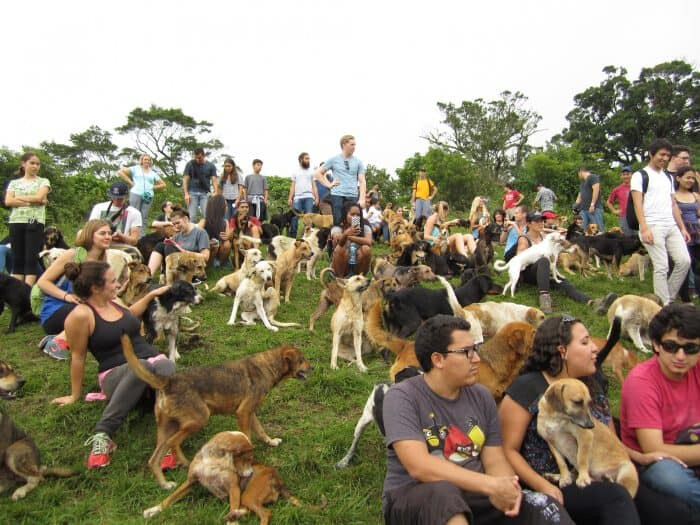
In the tranquil neighborhoods of Costa Rica, a familiar scene unfolds daily: the unexpected calling cards left by roaming street dogs. While some residents might express frustration, others, like one homeowner in particular, have adopted a more understanding perspective. "I take it in stride," he explains, recounting his routine of cleaning up after the uninvited visitors. "After all, we also own a barrio dog, and there's a good chance our Dorothy has left a similar surprise for a neighbor."
Dorothy, their own "barrio dog," is a testament to the resilience of these street-smart canines. Rescued as a vulnerable puppy abandoned in a box, she embodies the independent spirit often seen in dogs who have spent their early months navigating the challenges of street life. Despite being spayed to prevent unwanted litters – a wise decision given her Houdini-like escapes from their property – Dorothy's ingrained instincts remain strong. "We've reinforced fences and added obstacles," her owner shares, "but she always finds a way through. Without being spayed, she would undoubtedly be a 'barrio slut-dog' by now."
Costa Rica is home to a significant population of rescue dogs, many of whom have developed these characteristic "barrio dog" traits through necessity. Their early experiences fending for themselves on the streets have shaped their unique behaviors and survival skills.
Decoding the Barrio Dog: A Checklist of Common Traits
Based on his observations of Dorothy, the homeowner has compiled a list of common characteristics exhibited by barrio dogs:
Selective Affection: Craves attention and cuddles at home but pointedly ignores owners when out in public.
Street Evasiveness: Will readily run away when approached by familiar humans on the street.
Communal Barking: Eagerly joins in any chorus of barking dogs in the vicinity.
Adaptable Sleeping Habits: Can comfortably sleep virtually anywhere – under tables, parked cars, or in simple dirt patches.
Weather and Social Flexibility: Readily adapts to indoor or outdoor sleeping arrangements depending on the weather and the presence of other canine companions.
Traffic Savvy: Possesses an uncanny ability to navigate busy street traffic with remarkable skill and awareness.
Street Scavenger: Exhibits a tendency to collect random, often peculiar, objects found on the street.
Gutter Gourmet: Shows a distinct preference for drinking standing water from gutters over fresh, clean tap water.
Escape Artist: Can slip out of collars and harnesses with impressive, almost magical, ease.
While traditional dog training might seem like an obvious solution, the homeowner's attempt with instructional videos proved hilariously unsuccessful. "I bought a puppy training video, but it was completely useless because she refused to sit down and watch it with me," he jokes.
However, through trial and error, he has discovered a kryptonite for his elusive companion: the irresistible allure of soup bones from the local carniceria (butcher shop). While Dorothy may feign deafness to calls from a distance, the mere sight of a bag filled with marrow-rich bones and meaty scraps triggers an immediate, high-speed return home.
"Some dogs are naturally obedient, while others are simply wired as the 'barrio type'," the homeowner concludes with a knowing smile. "But one thing is universally true: no dog, regardless of its street smarts, can resist the siren call of a good soup bone."
Beyond the Quirks: Understanding Costa Rica's Street Dog Population
The presence of "barrio dogs" in Costa Rica reflects a complex interplay of factors, including a history of stray animals, cultural attitudes towards pet ownership, and the dedicated efforts of local rescue organizations. While these dogs often exhibit independent and sometimes challenging behaviors, they are also incredibly resilient and adaptable, carving out a life for themselves in urban and rural environments alike.
Organizations across Costa Rica work tirelessly to rescue, rehabilitate, and rehome these animals. Spay and neuter programs are crucial in managing the street dog population and preventing further abandonment. The story of Dorothy highlights the potential for these street-smart canines to become beloved family members, even if their past experiences leave an indelible mark on their personalities.
The homeowner's acceptance of Dorothy's unique "barrio dog" traits, coupled with the effective use of soup bones, offers a heartwarming glimpse into the bond that can form between humans and these resourceful survivors. It also serves as a reminder of the diverse personalities and histories that each rescue dog brings, enriching the lives of those who open their homes and hearts to them.
[Copyright (c) Global Economic Times. All Rights Reserved.]





























